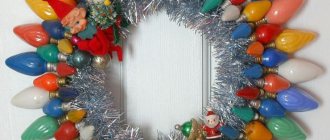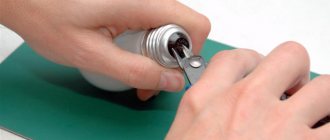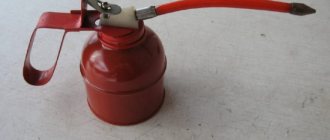Color music or simply lighting with an unusual color is an interesting solution that can be useful in the design of any room. It is quite difficult to find bright light bulbs on the market and in stores, so the only way out is to create colored light bulbs yourself.
Conventional painting options may not be suitable for imparting color to a light bulb, since it will burn the applied layer due to heating. Therefore, for work it is recommended to choose energy-saving LED lamps or 25-watt incandescent lamps. When working on a light bulb, you must remember that the color and brightness of the glow will depend on the density of the color coating.
Using different dyes, coating intensity and the methods described below, you can create a rich collection of different light bulbs with an interesting glow in a few minutes.
Coloring with paste
To color your pen blue, you can use paste from a ballpoint pen. To paint the lamp in the color of the selected paste, you will need to carefully remove the tip and blow the ink onto a sheet of paper or oilcloth. Then, holding the light bulb by the base, rub it with the leaked contents of the pen. You can control the intensity of the coating using acetone, cologne or alcohol.
Why paint a light bulb?
Before choosing what to paint a light bulb with, you should clarify whether the method is suitable for achieving your original goals. Painting lighting fixtures is usually becoming an alternative to purchasing ready-made elements. Colored dyes are most often used for:
- Eliminating their possible theft at the entrance. They are usually stolen for further resale or use at home, but lamps painted in a different shade or darkened are not suitable for this. This reduces the risk of theft of lighting in the house.
- Creation of light music. Using lamps of different colors will help create an unusual atmosphere in the house, which is suitable for creating home parties and discos.
- Zoning of space. You can use different shades to highlight or emphasize different areas in the apartment. The paint used for light bulbs is not bright, but muted tones are suitable for changing the color scheme of the room.
- Decoration of rooms. Creating small illumination of shelves or other elements can be done by changing the color of the lighting, which usually looks impressive.
Instead of painting the light bulbs yourself, you can buy ready-made devices. However, keep in mind that their prices vary greatly - with home painting you can save up to 60 percent of the price. In addition, you can choose an unusual color scheme, which is not always available ready-made. The initial goals for coloring a light bulb may be different, but keep in mind that if the dye is used correctly, it does not lose its technical characteristics, which is why it can be used for regular room lighting, even after repainting it red. This is interesting: painting organic glass.
Example of using colored light bulbs
Tsaponlak
You can purchase this coating at a store specializing in radio components. The main function of the coating is to protect tracks and soldering from short circuits. Since the operating temperature of transistors reaches 150 degrees, the product is also suitable for coating light bulbs.
These are the simplest and most affordable ways to coat a rather capricious material - glass. The choice is narrowed several times if the question concerns light bulbs that burn often and for a long time, because not all dyes can withstand high temperatures.
Source
Difficulties in painting at home
Among the main problems of dyeing at home are:
- difficulties in selecting a dye for a specific lamp;
- inability to properly treat the surface before painting;
- lack of specialized tools.
If you don’t have the desire or free time to study the nuances of painting, then you can simply purchase a ready-made painted lamp in a store. To choose the right paint, you need to familiarize yourself with the table of lamp temperatures depending on the type and power:
| Type | Surface temperature |
| Incandescent lamp, 25 watt | 100 C |
| Incandescent light bulb, 75 watt | 250 C |
| Energy saving | 100 C |
| LED | 40-50 C |
High-power halogen lamps have the highest surface temperature, so it is impossible to paint them at home without special preparation. If you need to do quick coloring, then using improvised means you can get an acceptable result. High-quality painting requires more careful preparation and the use of wear-resistant paints.
Source
Possible problems
Before changing the color scheme of the device at home, keep in mind that the lamp gets very hot during operation. This becomes the main problem when repainting. When using conventional pigments that are not intended for use under high temperatures, the coating quickly dries out and cracks. This is reflected in the deterioration of the visual result, and in the possible overheating of the light bulb when the dye melts. The heating of a light bulb depends on its characteristics:
- A light bulb with a capacity of 25 W and energy saving heats up to 100 degrees Celsius;
- Capacity 40 W – 150 degrees;
- Capacity 75 W – 250 degrees;
- Halogen lamp, capacity 275 W – up to 550 degrees;
- LED – up to 50 degrees.
Pay attention to: Painting a metal garage
The less the lamp heats up, the easier it is to repaint it, obtaining a lasting result. However, with halogen lamps it is much more difficult - due to the high heating temperature, almost no product lasts more than half an hour on them in the same state. But the plastic base of the LED lamp practically does not heat up - only the power source, which is located in its base, heats up. No paint is applied to it, so this type is most convenient to use for painting.
Damage to paint due to overheating
Cracking paint
What you need to know about artificial light sources used for growing plants
First, let's look at the characteristics of natural lighting, which we will take as a sample.
What the spectrum of the Sun looks like on a summer day - our standard for designing a phytolamp
I show the results of a practical experiment. Measuring the wavelengths of sunlight was carried out with a spectrophotometer at noon in clear summer weather and showed the following picture.
The abscissa axis of this graph represents the wavelength in nanometers, and the ordinate represents the power in watts per square meter of irradiated area. All colors from ultraviolet to infrared are present here, which are actively absorbed by plants for their growth.
They especially need the spectrum:
- ultraviolet (380-410 nm);
- blue (445-460 nm);
- red (630-660 nm);
- infrared (690-730 nm).
Plants do not use other spectra.
Good photosynthesis in seedlings occurs when backlight lamps create optimal radiation. At the same time, the energy of sunlight, as well as water and carbon dioxide, is converted into organic substances - green mass.
It is enough for us to take this test as a basis for designing future homemade products.
4 types of spectrum from the most popular sources in everyday life: how they differ from natural light
I show the results of four experiments performed with the same Ocean Optics STS-VIS artificial light spectrophotometer with incandescent filament, LED, Filament and compact fluorescent light bulb (CFL).
The spectrum from one 75-watt incandescent lamp at a distance of 50 cm from it looks like this.
It is clearly noticeable that it is strongly shifted towards red tones at the limit of 630-660 nanometers, and there are very few shades of blue and green.
An incandescent lamp has low light output and is characterized by increased heat generation. The illumination from it reached 380 lux.
For reference, I remind you of the relationship between lux and lumen.
The color temperature of the incandescent lamp was 2700 degrees Kelvin and lies in the warm white region, CRI=91.
It is convenient to compare it with LED sources.
Spectrum from a regular white 12 watt LED lamp
Here, the color spectrum and energy transfer ratio have a different picture, the color rendering index has reached 63.
The color temperature of the lamp is 3500 degrees, and the illumination in lux is 1110, which is almost three times more than that of incandescent lamps.
I’m just saying that the color rendering of sunlight (CRI) on a clear day is equal to 100 units, and all other sources are compared with it and divided into six characteristics.
Spectrum from an energy-saving 15-watt compact fluorescent lamp HLCT3
This is equivalent in power to Ilyich’s 75-watt light bulb. It showed 415 lux of brightness, a radiation power of 1.3 watts per square meter of area, and a color temperature of almost 6500 degrees Kelvin.
Color rendering was 82 units, which is slightly higher than that of the LED analogue, but the spectrum is cool white.
When comparing the results, remember that LEDs emit light strictly in one direction, and other sources emit light evenly in all directions.
This must be taken into account when designing a phyto lamp.
Spectrum from a Filament lamp with a power of 8 watts
Filament illumination was 95 lux, radiation power 0.3 watts per square meter, color rendering 2700 degrees K, CRI 75 units.
The measurements taken with a spectrophotometer allow us to conclude that not a single type of such popular lighting sources creates optimal lighting for growing plants.
However, even in this case, supplementary lighting with them plays a positive role, improving the growth of seedlings.
Important lighting information
Plants consume light energy in the range of 400÷700 nm. The light from this area is abbreviated as PAR (Photosynthetically Active Radiation).
Its energy is measured in watts and is characterized by the amount necessary for photosynthesis to occur. This is not a characteristic of the light source, but the seedlings’ need for light energy.
Biologists take into account its propagation by photons and measure their number in micromoles bombarding 1 square meter of area. It is designated FFP PAR (Photosynthetic Photon Flux).
(1 mol=6·1023 photons. 1 micromol=6·1017 photons.)
Effective painting methods
In order to change the color of a product, it is recommended to use highly effective painting methods. The best solution is to use specialized paint, which is created specifically for painting glass objects.
Ballpoint pen paste
If you don’t have time to find special paint, you can use ballpoint pen paste. To carry out staining using this method, you must perform the following steps:
- Take the stick with the paste.
- Remove the tip and extract the paste.
- Using a brush, apply the paste to the light bulb.
You can use either a blue or any other pen as a source of paint. The final result will depend on the amount of paste applied. It is worth understanding that using only ink from a ballpoint pen you will not be able to perfectly darken the product.
Nail polish
Using nail polish, low-power light bulbs are painted that do not heat up very much (the temperature during operation does not exceed 100 degrees C). The varnish has pronounced adhesion and durability. It can also be used to paint the entire surface evenly. You can use varnishes of any color, from yellow to red and green. Clear varnishes can be used as a base for other colorants. After applying the varnish, any other paint will adhere much better and with higher quality to the surface of the light bulb.
PVA glue is a good base for applying any coloring matter. If a high-quality result is required, it is recommended to create a layer of PVA before applying paint. Next, you can color the light bulb with ballpoint pen paste or special ink.
Auto enamel
Automotive enamel is a specialized paint that is sold in the form of an aerosol. Its advantages are good adhesion, convenience, high application speed and durability. Auto enamel is applied in a thin layer to achieve the desired darkening effect. You can find paint of any color on the market without any problems.
Application is carried out from a distance of 30-50 cm. Before this, the can is thoroughly shaken. It is important to make the layer thin so that the glass of the light bulb does not lose its transparency. If the layer is too thick, light will not pass through it.
Stained glass paints
Stained glass paints are created specifically for painting glass objects. With their help, you can give the glass the desired color while maintaining its transparency. To change the color of the light bulb, water-soluble stained glass paints are used that can withstand high temperatures.
Paints are sold in tubes. Substances must be applied in strict accordance with the instructions. You will first need to prepare the surface by cleaning and degreasing it. To give the light bulb a special look, purchase fluorescent paints with sparkles.
Tsaponlak
Tsaponlak is a varnish that is used to coat metal products and microcircuits to protect them from negative external influences. It is possible to purchase both transparent and colored tsaponlac. Using a colored liquid, you can try to paint a light bulb. The advantage of this varnish is resistance to high temperatures and wear resistance. The downside is the small selection of colors (only red and green tsaponlaki are available for selection).
Organosilicon
Organosilicon paints are characterized by extremely high heat resistance. They can be applied to coatings, which will subsequently heat up to temperatures above 500-600 degrees C. Organosilicon is used to color powerful light bulbs, which become very hot during operation. Before staining, it is recommended to dilute the dye with a solvent, otherwise the glass will be darkened too much. You need to act based on the instructions for the specific silicone-based paint.
Substitution rules
First you need to study the general rules for working with electrical equipment, which are mandatory when replacing light bulbs of any type. There is nothing complicated here, but nevertheless, most people neglect simple recommendations:
- It is advisable to buy dielectric gloves. They last for many years and can be purchased and stored in the pantry to be used when needed. You can work in them even if it is not possible to turn off the power supply when replacing a failed element.
- Use cloth gloves if the light bulb cannot be moved. When you cannot budge the threads and you need to apply a lot of force, it is better to wear durable gloves made of fabric or leather to protect your hand if the bulb breaks.
The tool must be dielectric. - Carry out work in good visibility. Since electricity most often turns off, and lamps burn out mainly at night, when they are turned on, it is necessary to provide lighting. If you have a headlamp, this is the best option, but you can ask someone to light it with their phone.
- Take a reliable stool or other device to reach the lampshade. Very often, when replacing a light bulb, people are injured not due to electric shock, but due to falling from an unreliable structure. The height should be such that you can work comfortably without having to stretch your arms.
- Always check for voltage with a multimeter or indicator screwdriver. After removing the light bulb, do not put your fingers into the socket without making sure that there is no current there. The check will take a few seconds, but will eliminate any problems.
For your information! Do not carry out work with wet hands, especially if the voltage is not turned off.
Method 4 - Auto enamel
Automotive enamels are sold in aerosol cans. Everything here is quite simple; you don’t need a lot of time and effort to paint a light bulb. Need to:
- Buy balloons with the desired colors.
- Spray paint on the light bulbs at a distance of 30-40 cm.
- Dry.
Advantages of this method:
- suitable for light bulbs with bulb temperatures up to 200°C;
- easy to use;
- dries quickly.
Important! Do not apply too thick a layer of paint, it can make the bulb opaque and the light bulb simply will not shine.











